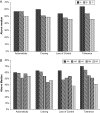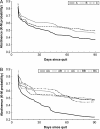Human neuronal acetylcholine receptor A5-A3-B4 haplotypes are associated with multiple nicotine dependence phenotypes
- PMID: 19436041
- PMCID: PMC2699926
- DOI: 10.1093/ntr/ntp064
Human neuronal acetylcholine receptor A5-A3-B4 haplotypes are associated with multiple nicotine dependence phenotypes
Abstract
Introduction: Previous research revealed significant associations between haplotypes in the CHRNA5-A3-B4 subunit cluster and scores on the Fagerström Test for Nicotine Dependence among individuals reporting daily smoking by age 17. The present study used subsamples of participants from that study to investigate associations between the CHRNA5-A3-B4 haplotypes and an array of phenotypes not analyzed previously (i.e., withdrawal severity, ability to stop smoking, and specific scales on the Wisconsin Inventory of Smoking Dependence Motives (WISDM-68) that reflect loss of control, strong craving, and heavy smoking.
Methods: Two cohorts of current or former smokers (N = 886) provided both self-report data and DNA samples. One sample (Wisconsin) comprised smokers making a quit smoking attempt, which permitted the assessment of withdrawal and relapse during the attempt. The other sample (Utah) comprised participants studied for risk factors for nicotine dependence and chronic obstructive pulmonary disease and included individuals originally recruited in the Lung Health Study.
Results: The CHRNA5-A3-B4 haplotypes were significantly associated with the targeted WISDM-68 scales (Tolerance, Craving, Loss of Control) in both samples of participants but only among individuals who began smoking early in life. The haplotypes were significantly associated with relapse likelihood and withdrawal severity, but these associations showed no evidence of an interaction with age at daily smoking.
Discussion: The CHRNA5-A3-B4 haplotypes are associated with a broad range of nicotine dependence phenotypes, but these associations are not consistently moderated by age at initial smoking.
Figures




References
-
- American Psychiatric Association. Diagnostic and statistical manual of mental disorders. 4th ed. Washington, DC: American Psychiatric Association; 1994.
-
- Baker TB, Moffit T, Caspi A, Conti D. The nicotine dependence phenotype: Translating theoretical perspectives and extant data into recommendations for genetic mapping. In: Swan GE, editor. The nicotine dependence phenotype, NCI Monograph No. 22. Washington, DC: U.S. Government Printing Office; (in press)
Publication types
MeSH terms
Substances
Grants and funding
LinkOut - more resources
Full Text Sources
Molecular Biology Databases

